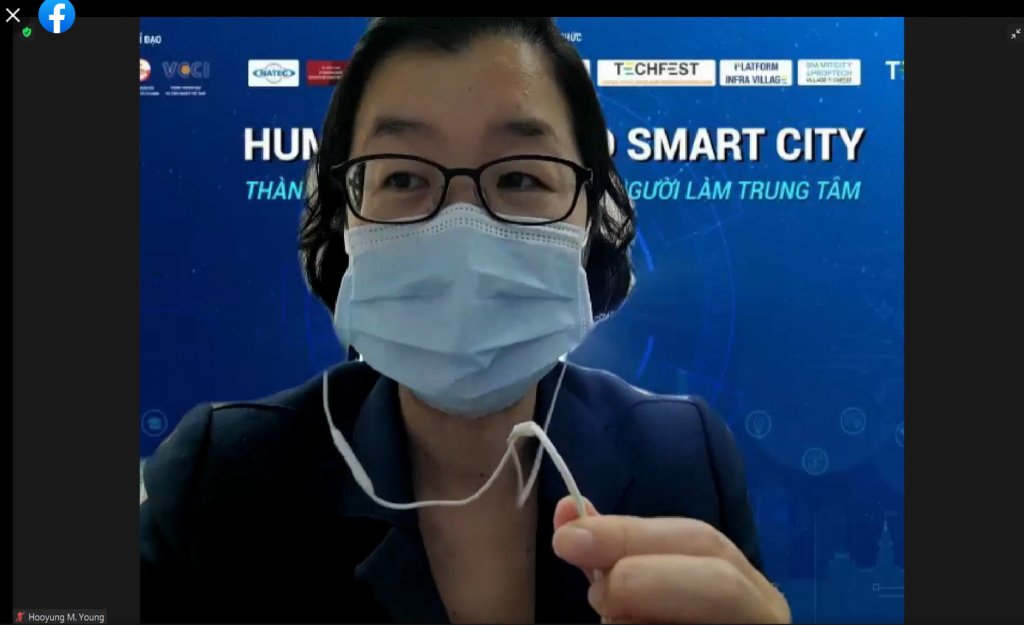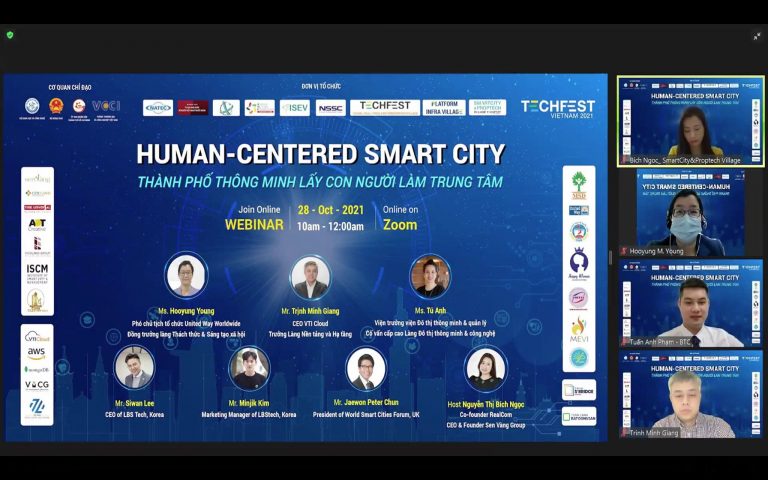
On October 28, 2021, the webinar with the theme “Human-centered Smart City” took place within the framework of TECHFEST 2021. The event was coordinated by three technology villages: SmartCity and Proptech Village, Platform and Infrastructure Village, Social Challenge and Innovation Village with the companionship of Shinhan Square Bridge. The conference brings together leading experts in smart cities domestically and internationally.
Currently, in the progress of developing smart cities, many developing countries are focusing on technology as the center. Although technology can bring many conveniences to users, it can ignore many needs that human need such as privacy, information security, other general needs of diverse groups of people.
Trinh Tu Anh – Director of the Institute of Smart Cities and Management shared: “A smart city is not a city that only uses technology but also a place where technologies are applied to solve problems. urban problems effectively based on the resources we have at our disposal. The ultimate goal of Smart City is still the quality of people’s lives, and people must be the central factor.”
Giving a welcome speech, sharing about the empirical model to promote opportunities for startup initiatives, Ms. Hooyung Young – Vice President of United Way Worldwide said: “The Shinhan Square Bridge Vietnam model was built and deployed based on the approach of promoting an experimental environment (www.livinglabvietnam.org) to create an opportunity for startups to test their innovative products and solutions at the real user community. This approach can also be used in the smart city approach – where the needs of people, diversed groups are at the heart, from which startups and stakeholders can try and build technology applications to serve human needs. Also, I would like to emphasize the attention to the vulnerable groups that a humanistic smart city cannot ignore.

* Smart urban development strategy: Need to focus on local people and culture
After many years of researching smart city models in the world, Mr. Jaewon Peter Chun – Chairman of WSCF and CEO of XnTree said: “Countries, including some large countries such as Japan, China, India, Korea, etc. when developing a new city, there are always problems such as scarcity of land, finance and even a shortage of human resources. In the face of many constraints, the focus is on answering human-related factors such as “Who will live in this city? How long will they live?” These are the questions that need to be asked, and the answers are at the core of what a city/city is, not what technology we use.” In addition, Mr. Peter also shared about the strategy of countries to focus on building cities based on their own characteristics to address social challenges and basic needs such as: Copenhagen builds an environmentally friendly city, Malaga applies smart energy, Singapore develops virtual reality technology, etc.

According to Mr. Trinh Minh Giang – CEO of VTI Cloud, all Smart City aim to focus on developing 3 main focuses: Firstly, the quality of life of everyone in the region, including those who are “vulnerable” such as the elderly, children and people with disabilities. The second is to ensure and increase the economic competitiveness of the city. When the city has a developed economy, it will attract high-quality labor as well as be able to develop its own internal resources. The third is to ensure sustainable development. “Smart City needs a strong information technology infrastructure and platform to be able to intervene and promote the fields of environment, education, security, transportation, economy, etc. to improve the quality of life for each person in the city”, Mr. Giang shared.

Sharing about the “Smart city without barriers for the visually impaired” model, which has been successfully implemented in Korea and is in the process of being piloted in District 10, Ho Chi Minh City with the support of the Shinhan Square Bridge, Mr. Siwan Lee – General Director of LBSTech said that one of the fundamental keys that smart cities need to solve is the issue of Social Security. He gave an example that during the pandemic, we often use QR codes or text messages on the phone, but this is very difficult for the visually impaired. So a smart city also has the ability to provide good support for the visually impaired, that is, there must be technology for the visually impaired to use. “Through the Welfare Smart City Platform, we provide a specialized digital mapping solution, providing accurate and fast information, helping the elderly and people with disabilities (especially the visually impaired) to move easily, and from there can participate in economic and social activities conveniently”.

* Solutions for smart city development after the pandemic.
At the discussion, the speakers focused on sharing the challenges of people living in smart cities in the context of the COVID-19 pandemic. Mr. Jaewon Peter Chun – President of WSCF and CEO of XnTree said the Covid-19 epidemic is disrupting the daily life of the people. Typically, in the US, people no longer go to the office and now participate in online meetings more. So they are used to this new model, they prefer to work from home and also save on office rental costs. It is expected that this model may become a new trend in the future. Therefore, smart cities must have plans to meet the new lifestyle.
When it comes to developing smart cities after the pandemic, Ms. Trinh Tu Anh – Director of the Institute of Smart Cities and Management pointed out 3 issues that planners and designers need to pay attention to. Firstly, only about 20% of people accept and change to the “work-from-home” trend. They are academic researchers or jobs that have been built on digital transformation before. However, for the “vulnerable” group, the existing infrastructure and resources are not ready to support them in changing to the new trend. Therefore, the work of technology developers and planners must work together to serve the change of all subjects.
Secondly, house designing and planning is suitable for the new lifestyle. Previously, all activities were held outside the community, but after the epidemic, everything was “taken home”. Therefore, the house needs to be designed to ensure public space but still ensure privacy so that people’s lives can take place more flexibly.
Thirdly, about the fact that projects and planning have not paid attention to the possibility of self-recovery after the epidemic. Typically, in the field of hospitals, because they do not follow a flexible disassemble model, we do not know how to handle these projects after the pandemic. Besides, we also lack flexible areas to deal with unexpected incidents like the Covid-19 pandemic.



